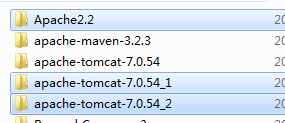写在前头
spring3.0以后就开始支持quartz2.x,因为org.quartz.CronTrigger在2.0从class变成了一个interface,Spring4.0.6配置文件中使用CronTriggerFactoryBean来集成quartz2.x,使用CronTriggerBean来集成quartz1.8.x及以前版本.
准备环境
我用的是spring4.0.6 + quartz 2.1.7
1. quartz官网:http://www.quartz-scheduler.org/
2. spring集成环境
<dependency>
<groupId>org.quartz-scheduler</groupId>
<artifactId>quartz</artifactId>
<version>2.1.7</version>
</dependency>
<dependency>
<groupId>org.quartz-scheduler</groupId>
<artifactId>quartz-oracle</artifactId>
<version>2.1.7</version>
</dependency>
<dependency>
<groupId>org.quartz-scheduler</groupId>
<artifactId>quartz-weblogic</artifactId>
<version>2.1.7</version>
</dependency>
<dependency>
<groupId>org.quartz-scheduler</groupId>
<artifactId>quartz-jboss</artifactId>
<version>2.1.7</version>
</dependency>
环境搭建
1. 创建数据库表结构
文件路径:quartz-2.1.7\docs\dbTables\*.sql
选择对应数据库的脚本,然后执行。我选择的ORACLE.

2. 创建quartz.properties文件
#============================================================================
# Configure Main Scheduler Properties
#============================================================================
org.quartz.scheduler.instanceName = EventScheduler
org.quartz.scheduler.instanceId = AUTO
org.quartz.threadPool.class = org.quartz.simpl.SimpleThreadPool
org.quartz.threadPool.threadCount = 10
org.quartz.threadPool.threadPriority = 5
org.quartz.threadPool.threadsInheritContextClassLoaderOfInitializingThread = true
#============================================================================
# Configure JobStore
#============================================================================
org.quartz.jobStore.misfireThreshold = 60000
org.quartz.jobStore.class = org.quartz.impl.jdbcjobstore.JobStoreTX
# mysql
#org.quartz.jobStore.driverDelegateClass=org.quartz.impl.jdbcjobstore.StdJDBCDelegate
# Oracle
org.quartz.jobStore.driverDelegateClass=org.quartz.impl.jdbcjobstore.oracle.OracleDelegate
org.quartz.jobStore.tablePrefix = QRTZ_
org.quartz.jobStore.maxMisfiresToHandleAtATime=10
org.quartz.jobStore.isClustered = true
org.quartz.jobStore.clusterCheckinInterval = 20000
3. 创建spring配置文件applicationContext-job.xml
<?xml version="1.0" encoding="UTF-8"?>
<beans xmlns="http://www.springframework.org/schema/beans"
xmlns:xsi="http://www.w3.org/2001/XMLSchema-instance" xmlns:context="http://www.springframework.org/schema/context"
xmlns:mvc="http://www.springframework.org/schema/mvc"
xmlns:p="http://www.springframework.org/schema/p"
xmlns:util="http://www.springframework.org/schema/util"
xsi:schemaLocation="
http://www.springframework.org/schema/beans
http://www.springframework.org/schema/beans/spring-beans.xsd
http://www.springframework.org/schema/context
http://www.springframework.org/schema/context/spring-context.xsd
http://www.springframework.org/schema/mvc
http://www.springframework.org/schema/mvc/spring-mvc-3.1.xsd
http://www.springframework.org/schema/util
http://www.springframework.org/schema/util/spring-util-3.2.xsd">
<bean id="jobService" class="com.test.service.TestJobservice"/>
<!-- 定义任务 -->
<bean id="vcaEventJobTask" class="org.springframework.scheduling.quartz.JobDetailFactoryBean">
<property name="jobClass">
<!-- 上面的任务代理类 -->
<value>com.test.service.DetailQuartzJobBean</value>
</property>
<property name="jobDataAsMap">
<map>
<!-- 实际的任务的Bean name,填上EventMonitorService的Bean name -->
<entry key="targetObject" value="jobService" />
<!-- 执行Bean中的哪个方法 -->
<entry key="targetMethod" value="executeTask" />
</map>
</property>
<property name="durability" value="true"></property>
</bean>
<!-- 任务触发器 -->
<bean id="eventTaskTrigger" class="org.springframework.scheduling.quartz.CronTriggerFactoryBean">
<property name="jobDetail">
<!-- 任务代理Bean name -->
<ref bean="vcaEventJobTask" />
</property>
<property name="cronExpression">
<!-- 配置表达式,这里表示每五分钟执行一次 -->
<value>0 0/1 * * * ?</value>
</property>
</bean>
<!-- 任务调度入口 -->
<bean autowire="no"
class="org.springframework.scheduling.quartz.SchedulerFactoryBean">
<property name="dataSource">
<ref bean="dataSource" />
</property>
<!-- 任务列表,可以配置多个任务加入到该List -->
<property name="triggers">
<list>
<ref bean="eventTaskTrigger"/>
</list>
</property>
<property name="configLocation" value="classpath:quartz.properties" />
<property name="applicationContextSchedulerContextKey" value="applicationContext" />
<property name="startupDelay" value="30" />
<property name="autoStartup" value="true" />
<property name="overwriteExistingJobs" value="true" />
</bean>
</beans>
4. 创建任务类
代理类DetailQuartzJobBean.java
package com.test.service;
import java.lang.reflect.Method;
import org.quartz.JobExecutionContext;
import org.quartz.JobExecutionException;
import org.springframework.context.ApplicationContext;
import org.springframework.scheduling.quartz.QuartzJobBean;
public class DetailQuartzJobBean extends QuartzJobBean {
private ApplicationContext applicationContext;
private String targetObject;
private String targetMethod;
public String getTargetObject() {
return targetObject;
}
public void setTargetObject(String targetObject) {
this.targetObject = targetObject;
}
public String getTargetMethod() {
return targetMethod;
}
public void setTargetMethod(String targetMethod) {
this.targetMethod = targetMethod;
}
public ApplicationContext getApplicationContext() {
return applicationContext;
}
/**
* 从SchedulerFactoryBean注入的applicationContext.
*/
public void setApplicationContext(ApplicationContext applicationContext) {
this.applicationContext = applicationContext;
}
@Override
protected void executeInternal(JobExecutionContext ctx)
throws JobExecutionException {
try {
// logger.info("execute [" + targetObject + "] at once>>>>>>");
Object otargetObject = applicationContext.getBean(targetObject);
Method m = null;
try {
m = otargetObject.getClass().getMethod(targetMethod,
new Class[] {});
m.invoke(otargetObject, new Object[] {});
} catch (SecurityException e) {
// logger.error(e);
} catch (NoSuchMethodException e) {
// logger.error(e);
}
} catch (Exception e) {
throw new JobExecutionException(e);
}
}
}
目标类TestJobservice.java
package com.test.service;
import java.text.SimpleDateFormat;
import java.util.Date;
import org.slf4j.Logger;
import org.slf4j.LoggerFactory;
public class TestJobservice {
private static final transient Logger logger = LoggerFactory.getLogger(TestJobservice.class);
public void executeTask() {
logger.info("executing at " + new SimpleDateFormat("yyyy-MM-dd HH:mm:ss").format(new Date()));
}
}

